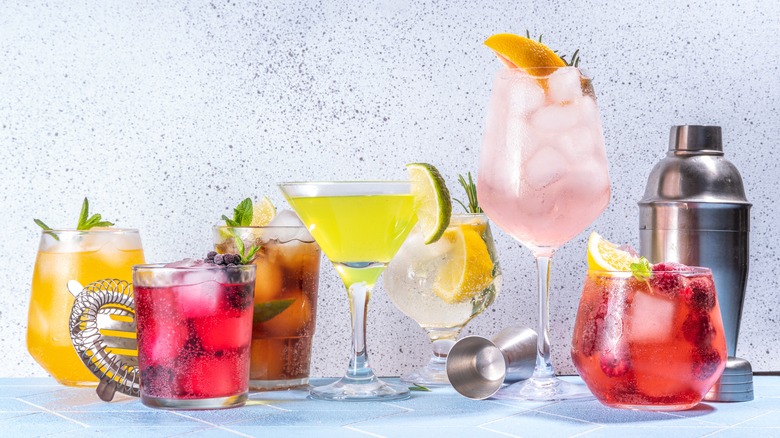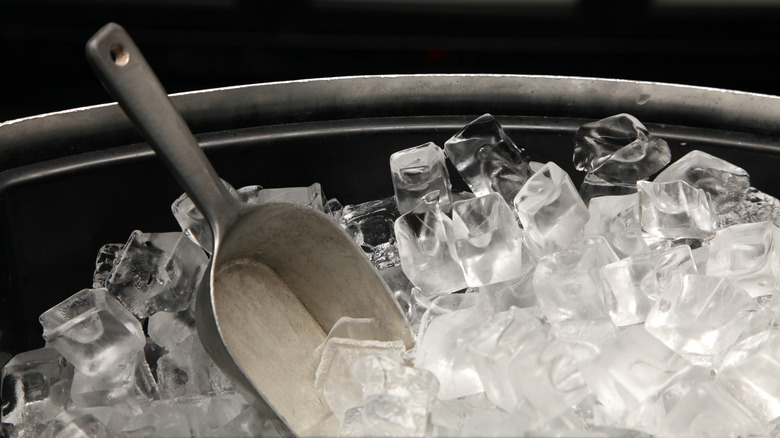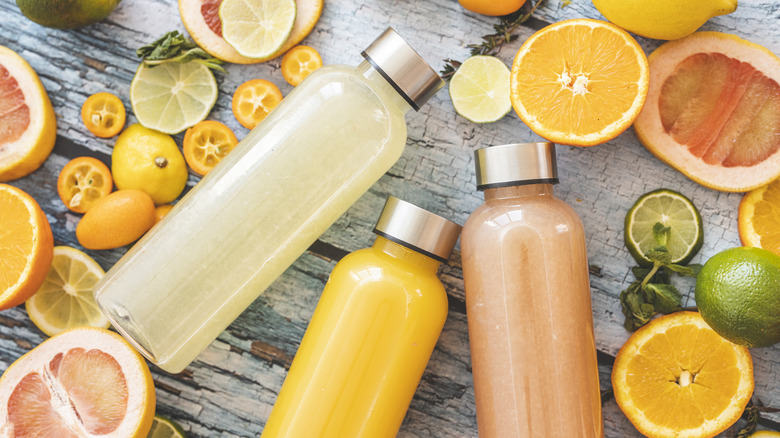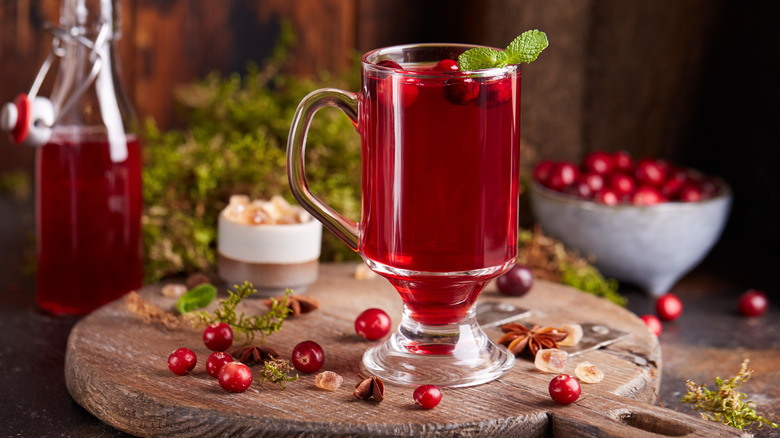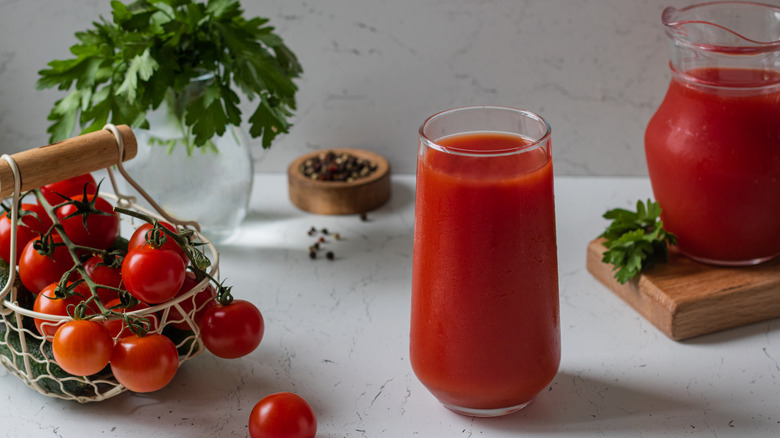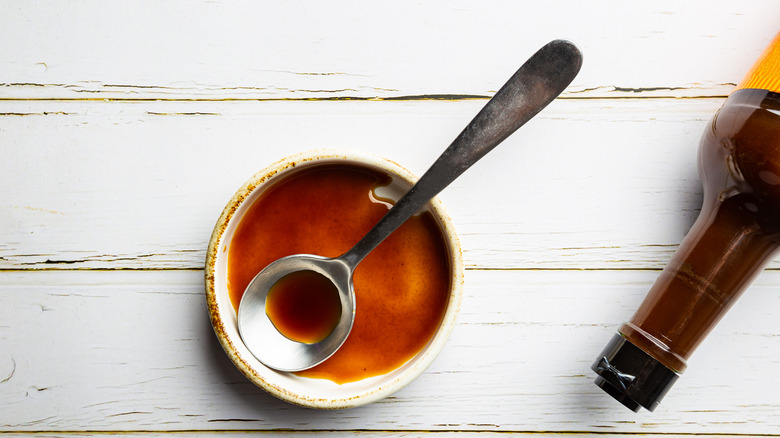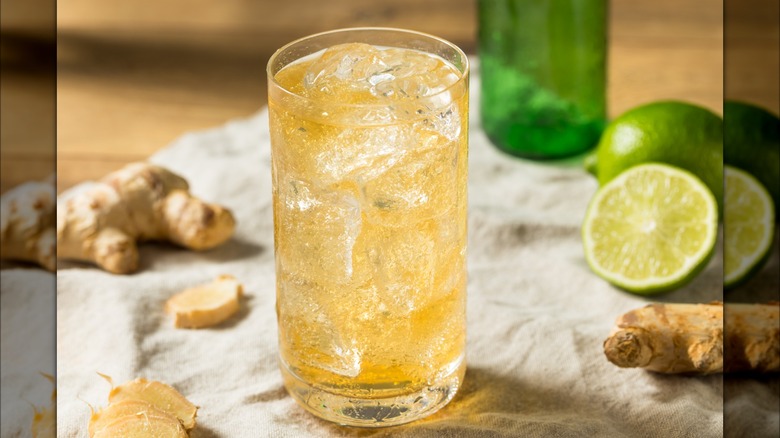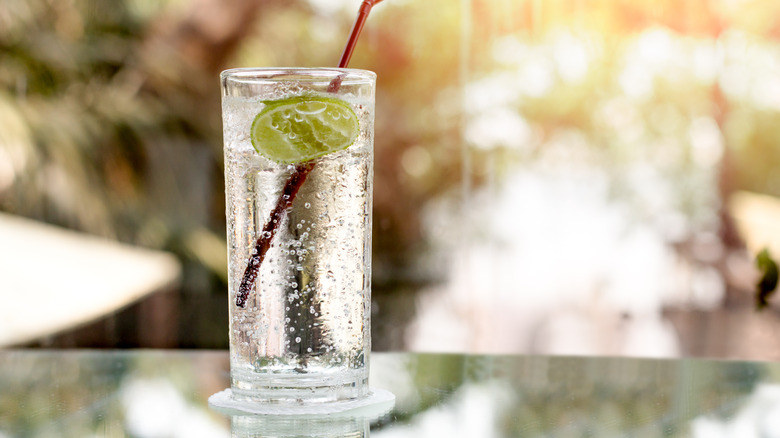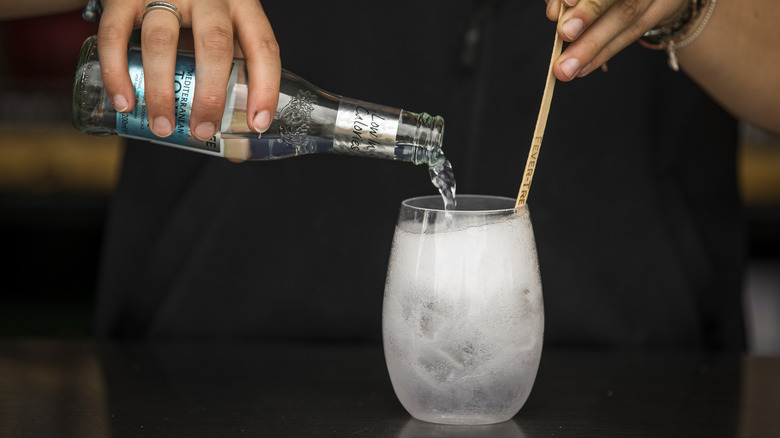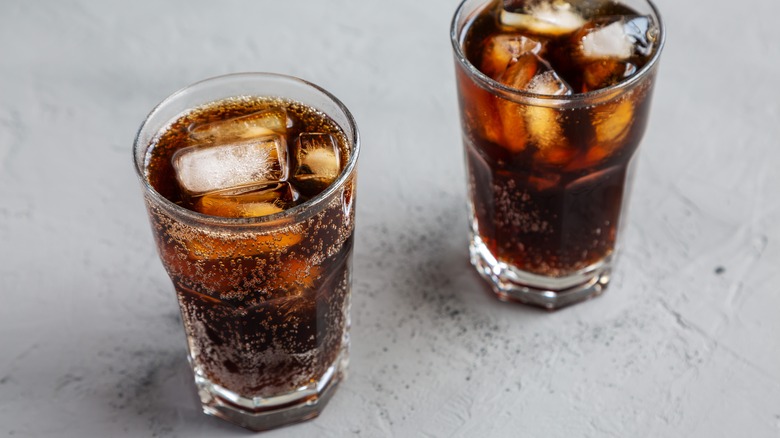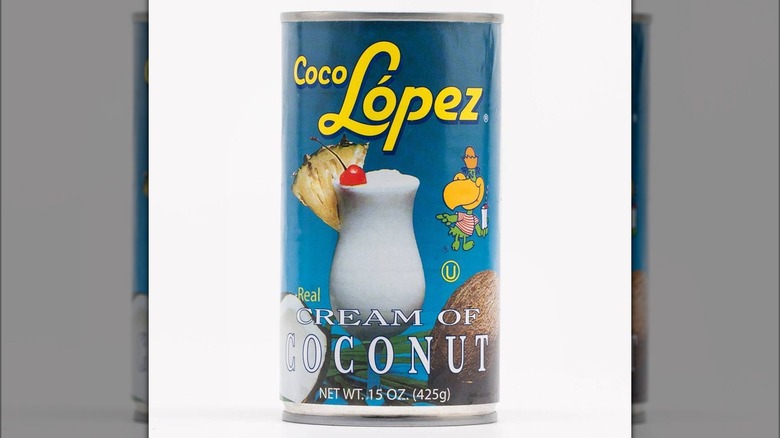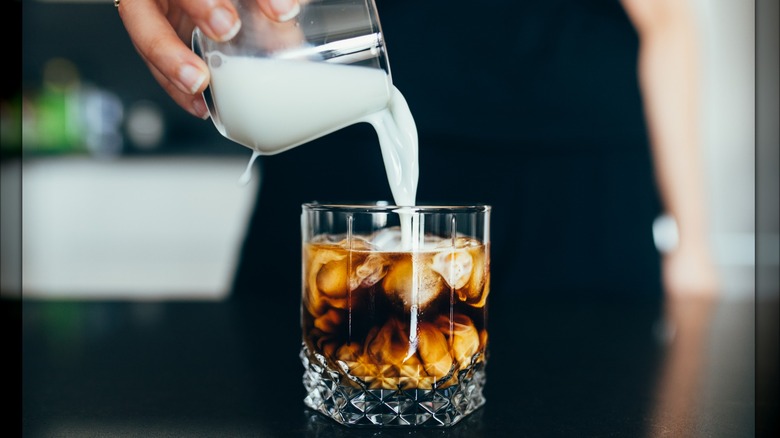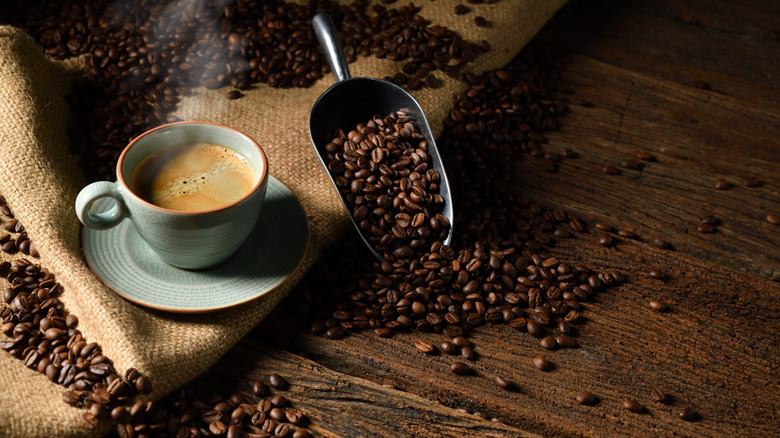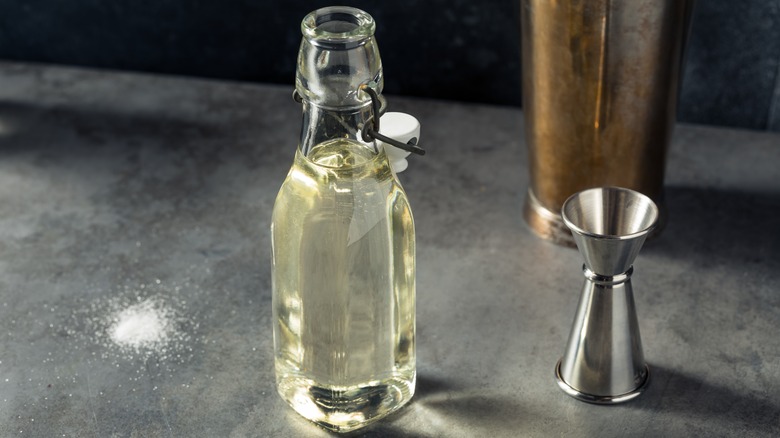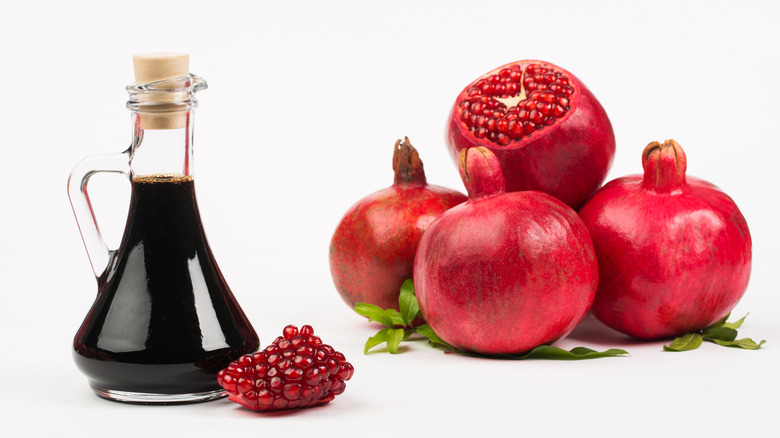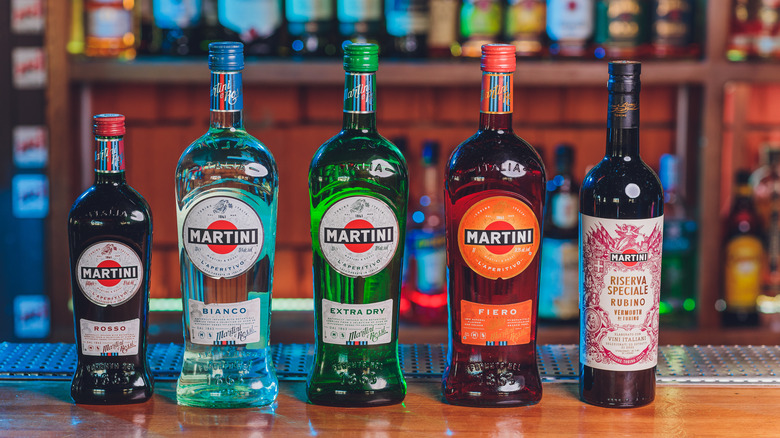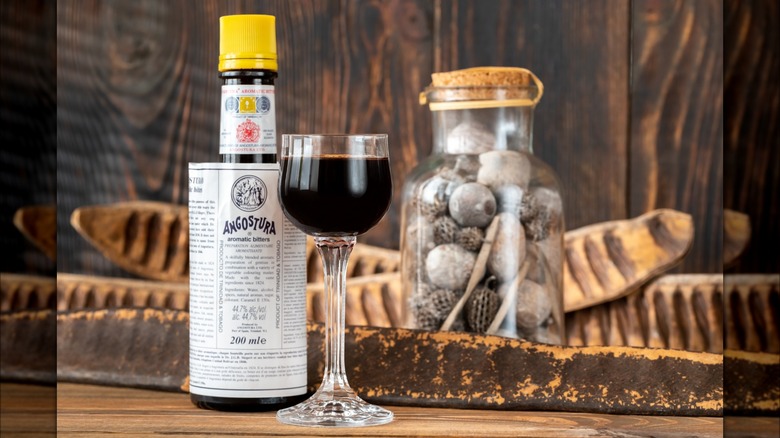16 Mixers Every Home Bar Should Have Stocked At All Times
For those who enjoy a nice drink, stocking the home bar with such essential spirits as tequila, whiskey, vodka, gin, and rum is an absolute must. The best bartending tools and glassware are also vital, all in an effort to make each and every drink a show-stopper. But with the possible exception of those who take their whiskey neat, additional ingredients are required if you truly want to mix up the perfect cocktail.
Unless you're operating a real bar, you likely don't have the space to stock every single juice, bitter, or flavored tonic out there. But there are a few mixers that should always be on hand, a few extras just in case friends pop over for an unexpected night in. Below is a compilation of the most mandatory mixers, those that should be kept on hand to make favorite cocktails at any time, whether it's a perfect martini, frozen margarita, or refreshing mojito.
Ice
Sure, ice is an odd choice for a mixer, but you can't have a drink without it. Whether enjoying a cocktail up or on the rocks, that drink won't be any good if it's lukewarm. After all, there's nothing more refreshing than an iced cold cocktail, and the best way to achieve that is frozen water. What's the best kind of ice? That's totally up to you.
These days it's all about clear ice cubes, because they look so pretty in the drink. But we've also seen ice with edible flowers as well as that adorable pebble ice that is consistently used to top off those spirit-heavy tiki drinks. There's more to ice than just looks, though. Ice also affects the drink itself.
When using a shaker, one large chunk is better than several refrigerator-generated cubes, because one large piece of ice will chill the drink without leaving ice chips behind. It also doesn't melt as quickly, which is why you often see a large sphere or cube added to a whiskey cocktail: It's cooling the drink while simultaneously adding the ideal amount of water to open up the spirit's unique flavors. As for that pebble ice, it makes a tropical drink look stellar, but those little pellets actually keep the drink cold without diluting it because they also melt slowly.
Citrus Juice
Citrus juices are an most important mixer because so many drinks — from margaritas to mojitos and screwdrivers to sours — use one form of citrus juice or another, some even combining two or three. The four basic citrus fruits are lemons, limes, oranges, and grapefruits. But each one has several varieties to choose from, and each will have a different impact on the final cocktail.
While you should always have lemon and lime juice, Brynn Smith, the Creative Bar Director of Bar Next Door in Los Angeles, also recommends grapefruit juice as well. "People love a Paloma, they love a salty dog," the bartender says. "I think fresh grapefruit is a great one to have."
Whatever citrus you choose, don't ever grab those little green or yellow plastic fruits from the grocery store. Fresh juice is always the best choice, as you'll know how ripe the fruit is and when the juice was extracted. Those plastic lemons and limes could have been sitting on the store shelf for weeks. Just remember that if you end up squeezing too much and have extra juice left over, the best way to store it is in the fridge.
Cranberry juice
Cranberry juice is the bright, red elixir synonymous with cape codders, cosmopolitans, and sea breezes. Created from a tart berry typically harvested in the late fall, it is great on its own or mixed into both cocktails and mocktails because it goes with everything from club soda to whiskey. Although this juice can be enjoyed year-round, it's frequently found in fall and winter drinks because it pairs so well with apples and oranges, both fall and winter fruits.
While there are several cranberry juice brands to choose from, Smith recommends those that are more artisanal and don't have a lot of sugar — you can always add the sugar yourself to balance out the drink. "Ocean Spray works great too," she says with a grin. "And I'm not a hater on that. So, I use Ocean Spray as well." When cranberries are in season, however, Smith likes to make a cranberry cocktail shrub that she'll use instead.
Tomato juice
Another bright red juice is used for more savory cocktails. Where cranberry is considered more of a fall and winter juice, tomato screams summer. It's bright and tart with a distinctly herbal essence, so you'll often see it in popular brunch staples like the bloody mary and michelada.
But it doesn't just make a delicious savory cocktail; tomato juice is good for you, thanks to all those antioxidants. This is also why tomato cocktails are often used as hangover cures. Not only are you getting a little hair of the dog that bit you, but you're replenishing your body with the nutrients and vitamins it lost the night before.
While tomato juice is always made with tomatoes, some brands, like V8, mix other vegetables like carrots and celery in for a more balanced flavor. Unfortunately, some brands try and make the drink more palatable by adding lots of salt. Those are the bottles to stay away from. After all, if you're mixing up drinks, you want to decide what goes in each one, not have it decided for you.
Worcestershire sauce
Worcestershire sauce is that weird, paper-wrapped bottle lurking in the back of your cupboard that only comes out to play when making marinades and bloody marys. While those are both good uses of the almost 200-year-old condiment, it deserves more attention. Because of its unique umami flavor, Worcestershire is a great choice when you want to add depth to your savory cocktails. Its long list of ingredients includes white vinegar, molasses, sugar, onions, anchovies, and garlic — taken as a whole it not only provides salt, but also a hint of sweetness and a necessary bite that levels up any drink.
If want to try something beyond the standard bloody mary, Worcestershire works great in a Caesar drink, a michelada, or the lesser-known bullshot (which is a cocktail comprised of beef broth, vodka, Worcestershire, Tabasco, lemon juice, salt, and pepper). But you needn't limit yourself to vodka, those umami flavors will also go great with a dry gin or earthy Bacanora.
Ginger beer
Ginger beer and ginger ale are sometimes confused, and while both are great mixers, ginger beer is the better choice as it tends to have more bite, so it can stand up to some of the stronger liquors. But spice isn't the only difference between ginger ale and ginger beer. The flavor is a big factor as well. Ginger ale isn't just significantly sweeter, the flavor tends to be more subtle, and if you're making something like a Moscow Mule or a Dark & Stormy, you want that burst of ginger to really come through.
While there are several ginger beers on the market, there are two that Smith always has in her bar: Fever Tree and Q Mixers, the latter being her favorite.
"I think Q Mixers does the best job at it," she says. "They put this dash of cayenne pepper in there, so there's this heat, that's, like, so subtle, but the flavor of ginger too, so it's a nice mix."
Club Soda
Can you imagine a mojito without bubbles? What about Ranch Water or an Aperol spritz? These drinks might not have become classics if not for club soda, making it a must-have in any home bar. There are so many drinks to mix with it, including a few from Prohibition. But if you stock soda in your bar, Brynn Smith says to make sure it's a premium brand, once again recommending Q mixers. While she believes that Schweppes makes a perfectly "delicious" club soda, Smith says having a more "artisanal one" is best if you're a craft cocktail lover.
Although club soda is the preferred choice when it comes to bubbles, it's not your only option. Both sparkling water and seltzer also provide a delightful fizz. But when compared in a taste test, there's a clear difference between the two. Sparkling water and seltzer both have minerals and bubbles, but club soda has a hint of salt thanks to the sodium added during its creation.
Whichever bubbly water you choose, make sure you get small bottles or cans so you always have fresh bubbles. The last thing anyone wants in a sparkling cocktail is flat soda.
Tonic Water
If you've ever ordered a vodka soda and gotten a distinctly bitter jolt upon tasting it, you've received a vodka tonic instead. Yes, all it takes is one sip to appreciate the difference between the two clear mixers. Unlike soda (which is practically flavorless), tonic is made with quinine, which gives it a distinct, bitter zing. (It also prevents malaria, which is why some believe the classic gin and tonic was invented in the first place.)
That bitter bite blends well with most liquors — from tequila to vodka — and creates a simple cocktail without all the extra mixers. Yes, a little squeeze of lemon or lime is often added to cut the bitterness, but it's not necessary. In fact, tonic has so much flavor on its own, you could enjoy the bubbly elixir over ice by itself and have a lovely mocktail. If you do choose that route, go with a flavored tonic instead. While there are several tonic water brands to choose from, Fever Tree is the tops, thanks to its elderflower and cucumber options.
Cola
Whether it's one half of an alcoholic beverage or merely a splash, cola has been added to cocktails for at least a century. Not only does it add that delightful fizz, but it also provides a sweetness and flavor that just can't be duplicated. Created by Dr. John Pemberton in 1886 as a tonic for various ailments, cola served as the perfect mask for the more questionable liquors served during Prohibition. It stuck around after liquor became legal again, and today is one of the most mandatory mixers to have on hand; numerous drinks that can be made with it, from a Jack & Coke or Cuba Libre to the liquor-heavy Long Island Iced Tea.
While Coca-Cola is the obvious choice, thanks to well-known cocktails with Coke in the name, Pepsi as well as a variety of other popular colas work just as well. It comes down to your personal preference. Some people even prefer Diet Coke, because of its unique flavor and the hopeful notion that your beverage will have fewer calories.
Cream of coconut
Blending ice and using it to make alcoholic slushies is a great way to beat the heat, but nothing's better on a sweltering day than a cool, creamy cocktail. Boozy milkshakes are great, but so are tall drinks in curvy glasses with beautiful garnishes.
If you want a tropical cocktail, coconut is the way to go. But unless you're going to make your own coconut milk, buy a can or two of cream of coconut to keep on hand.
Not to be confused with coconut cream, cream of coconut is its sweeter, thicker cousin usually reserved for desserts or tropical cocktails. It's also a great vegan alternative that delivers both sweetness and creaminess to cocktails without using cow's milk. This is the stuff you want to pull out when you're hosting a tropical party where piña coladas, Bushwackers, and Painkillers will be served. Even though you could achieve that same silky texture and tropical feel by using coconut cream or coconut milk, the sweetness that comes with cream of coconut means you can leave the simple syrup on the shelf and just add juices and spirits to create a show-stopping tiki cocktail worthy of the Hawaiian islands.
Cream
Plenty of drinks are comprised of a spirit, a sweetener, and something sour, but certain drinks just scream for cream. The white Russian, Grasshopper, or Mudslide wouldn't be beloved after-dinner drinks if they didn't have that velvety mouthfeel only achieved by adding an ounce or two of the white liquid. While these drinks are often on the sweeter side, they're still worth a sip at the end of the night as a nice alternative to the more popular amaros or digestifs.
The trick, however, when it comes to creamy cocktails is mixing them correctly. You want to use a cream with a higher fat content; whole milk or heavy cream mixes better than skim. For a vegan alternative, Brynn Smith recommends coconut or oat milk as good options that have a similar consistency. Your cream should always, always be nice and cold. Finally, if you're making a cocktail that uses a shaker, make sure you give that drink a long, vigorous shake to give your drink a nice, frothy texture.
Coffee
Clearly, the espresso martini is having a moment. It's the drink everyone seems to want, whether they're enjoying a night out on the town or a romantic evening at home. But coffee cocktails have been around for decades. How many times have you asked for the dessert menu and noticed a Mexican or Irish coffee listed? These days, you can even find them on brunch menus as an alternative to the more common mimosa or bloody mary. If you're going to whip up coffee cocktails at home, obviously, you need to have coffee in the pantry.
When mixing up an espresso martini or Irish coffee, Smith says not to use the standard drip coffee you drink first thing in the morning. "When you're making coffee in a cocktail make sure to have a concentrated amount," she explains. "Espresso or, like, a cold brew concentrate behind the bar are good to have."
Simple Syrup
The golden ratio for the perfect cocktail is two parts spirit to one part sweet and one part sour. Most of the time, that sweet comes from simple syrup. One of the easiest mixers to make at home, it's a simple combination of equal parts sugar and water. After that, you have free reign to create any kind of syrup you like. Want a rich demerara syrup? Add double the sugar. Want a flavored syrup to enhance the cocktail? Steep your favorite herb, fruit, or spice in the sugar-water for 20 minutes, and then strain.
Smith believes it's "just easier" to have plain simple syrup behind the bar, then muddle in any fruits or herbs you want for a specific cocktail later. That way you won't have a bunch of different flavored syrups you're not likely to use, because like most mixers, syrup has a shelf life — if properly stored and refrigerated, you'll get about a month.
"Keep it in a jar with a nice, tight lid so less oxygen gets in," she adds. "Or a container that's airtight."
Grenadine
Grenadine is that bright, cherry red syrup most commonly used to make the grandmother of all mocktails, the Shirley Temple — as well as the Roy Rogers. The perfect addition to these fizzy drinks everyone grew up with, the sweet yet slightly tart mixer is also a necessary ingredient in several adult cocktails, from the tequila sunrise to the hurricane.
Even though you can find bottles in most grocery and liquor stores, these store-bought versions typically contain large amounts of corn syrup, preservatives, and artificial flavorings. So, Smith recommends brewing your own.
Consisting of just a few ingredients (pomegranate juice, sugar, and orange blossom water) this syrup is easy to create at home. But you don't have to stick with the basics. Smith thinks "it's fun to use the leftover syrup from Luxardo cherries" as well. Just like simple syrup, homemade grenadine will also stay fresh in the refrigerator for up to a month.
Vermouth
One of only two spirits on this list, every home bar should have a bottle of vermouth. But Smith believes you should actually have "at least two." While there are several different varieties of vermouth available, the two most popular are French and Italian, more commonly known as dry and red. They also happen to be the two that Smith recommends stocking. By owning those two bottles, you can make dozens of cocktails — and if you buy a higher-quality version, you can even enjoy it on its own as an aperitif.
Unlike most liquors in your bar, vermouth is a fortified wine, which means it's one of the few liqueurs that should always be kept in the refrigerator once opened. Keeping vermouth refrigerated will extend its shelf life to three months, which — while shorter than most liquors — is significantly longer than a nice bottle of wine. A longer shelf life equates to more time to enjoy those martinis and Negronis, two cocktails that depend on vermouth to complete them.
Bitters
The other liquor on this list, bitters is the one ingredient you absolutely shouldn't skip when stocking your home bar. After all, a dash or two can make or break a drink. Originally created as a medicinal tonic for assisting in treatment of various ailments, bitters are made up of several botanicals that are soaked in pure alcohol to create intense flavors. Depending on what herbs or spices are employed, the bitters could add a sweet, spicy, earthy, or floral note to a drink. In short, bitters are a way to add tons of flavor without adding an extra ounce or two of liquid.
There are so many different flavored bitters available today that you could make the exact same cocktail three times, changing only the bitters, and each would be a completely unique experience. While you could stock dozens of bitters, Brynn Smith says no bar should be without the "holy trinity": Angostura, orange, and Peychaud's. Just having those three bottles behind your home bar makes most classic cocktails a possibility, and makes you look like a pro.
